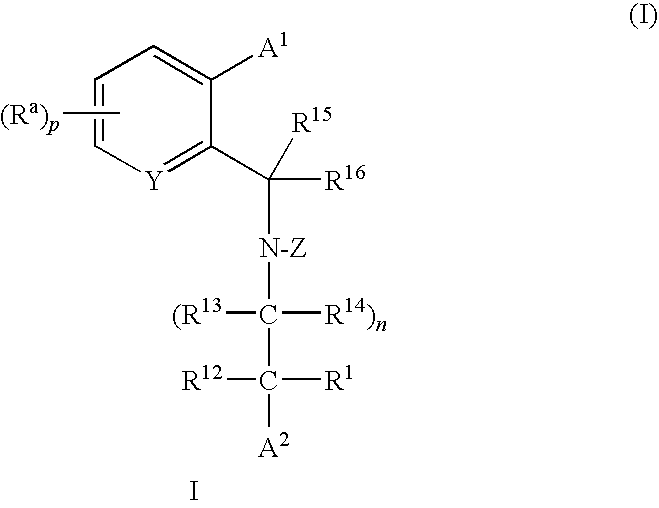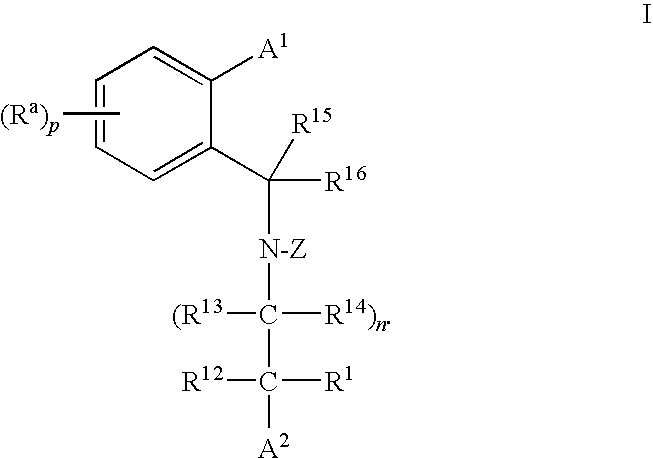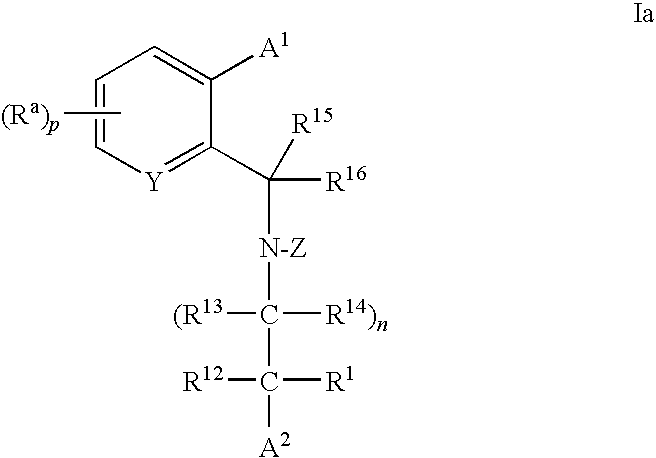Cholesteryl Ester Transfer Protein Inhibitors
a technology of cholesteryl ester and transfer protein, which is applied in the direction of peptide/protein ingredients, extracellular fluid disorder, metabolic disorder, etc., can solve the problems of only achieving a risk reduction of approximately one-third, and the serum hdl-c level is associated with an increased risk of chd,
- Summary
- Abstract
- Description
- Claims
- Application Information
AI Technical Summary
Problems solved by technology
Method used
Image
Examples
example 1
[0217]
N-[3,5-bis(trifluoromethyl)benzyl]-N-{[4′-fluoro-5′-isopropyl-2′-methoxy-4-(trifluoromethyl)biphenyl-2-yl]methyl}-2-methyl-2H-tetrazol-5-amine
[0218]To a stirred suspension of sodium hydride (60% in oil; 12 mg, 0.31 mmol) in THF (1 mL) at 0° C. under an atmosphere of N2 was added N-[3,5-bis(trifluoromethyl)benzyl]-2-methyl-2H-tetrazol-5-amine (Intermediate 1; 48 mg, 0.15 mmol) portionwise. The resultant solution was stirred at 0° C. for 20 min prior to the addition of a solution of 2′-(bromomethyl)-4-fluoro-5-isopropyl-2-methoxy-4′-(trifluoromethyl)biphenyl (Intermediate 12; 50 mg, 0.12 mmol) in THF (1 mL). The reaction was allowed to warm to room temperature and stirred for 14 h. The reaction was quenched with H2O and was partitioned between H2O (15 mL) and EtOAC (25 mL). The aqueous layer was re-extracted with EtOAc (3×25 mL) and the combined extracts were washed with brine (25 mL), dried (MgSO4), filtered and concentrated in vacuo. The residue was purified by flash silica ge...
example 2
[0219]
N-[3,5-bis(trifluoromethyl)benzyl]-N-{[4′-fluoro-5′-isopropyl-2′-methoxy-4-(trifluoromethyl)biphenyl-2-yl]methyl}-1-methyl-1H-1,2,3-triazol-4-amine
Step A: N-[3,5-bis(trifluoromethyl)benzyl]-1-methyl-1H-1,2,3-triazol-4-amine
[0220]3,5-bis(trifluoromethyl)benzaldehyde (42 μL, 0.25 mmol) was treated with 1-methyl-1H-1,2,3-triazol-4-amine (25 mg, 0.25 mmol) followed by sodium borohydride (19 mg, 0.51 mmol) as described in Intermediate 1. The residue was purified by flash silica gel chromatography (0-75% EtOAc / hexanes gradient) to afford N-[3,5-bis(trifluoromethyl)benzyl]-1-methyl-1H-1,2,3-triazol-4-amine as a white solid. LCMS=325.2 (M+1)+. 1H NMR (CDCl3, 500 MHz): δ 7.85 (s, 2 II), 7.79 (s, 1 II), 6.68 (s, 1 II), 4.48 (s, 2H), 3.97 (s, 3H).
Step B: N-[3,5-bis(trifluoromethyl)benzyl]-N-{[4′-fluoro-5′-isopropyl-2′-methoxy-4-(trifluoromethyl)biphenyl-2-yl]methyl}-1-methyl-1H-1,2,3-triazol-4-amine
[0221]N-[3,5-bis(trifluoromethyl)benzyl]-1-methyl-1H-1,2,3-triazol-4-amine (Step A; 44 mg,...
example 3
[0222]
N-[3,5-bis(trifluoromethyl)benzyl]-N-{[2′-chloro-5′-isopropyl-4-(trifluoromethyl)biphenyl-2-yl]methyl}-2-methyl-2H-tetrazol-5-amine
[0223]To a solution of N-[3,5-bis(trifluoromethyl)benzyl]-N-[2-iodo-5-(trifluoromethyl)benzyl]-2-methyl-2H-tetrazol-5-amine (Intermediate 10; 37 mg, 0.06 mmol)
and (2-chloro-5-isopropylphenyl)boronic acid (18 mg, 0.91 mmol) in THF (1.0 mL) was added aqueous 1M K2CO3 (1.0 mL) and the solution was degassed with nitrogen for 2 minutes. 1,1-bis(di-t-butylphosphine)ferrocene palladium dichloride (7.8 mg, 0.12 mmol) was added and the solution was heated under reflux for 14 h. The reaction was cooled to room temperature, poured into H2O (5 mL), and extracted with EtOAc (3×15 mL). The organic layers were combined and washed with brine (25 mL), dried over Na2SO4, filtered, and concentrated. Purification by flash chromatography on silica gel eluting with 15% EtOAC / hexanes afforded N-[3,5-bis(trifluoromethyl)benzyl]-N-{[2′-chloro-5′-isopropyl-4-(trifluoromethy...
PUM
 Login to view more
Login to view more Abstract
Description
Claims
Application Information
 Login to view more
Login to view more - R&D Engineer
- R&D Manager
- IP Professional
- Industry Leading Data Capabilities
- Powerful AI technology
- Patent DNA Extraction
Browse by: Latest US Patents, China's latest patents, Technical Efficacy Thesaurus, Application Domain, Technology Topic.
© 2024 PatSnap. All rights reserved.Legal|Privacy policy|Modern Slavery Act Transparency Statement|Sitemap



